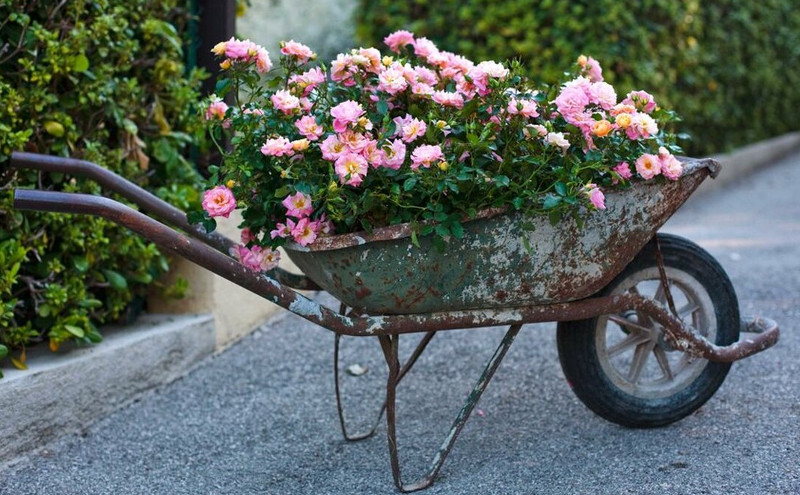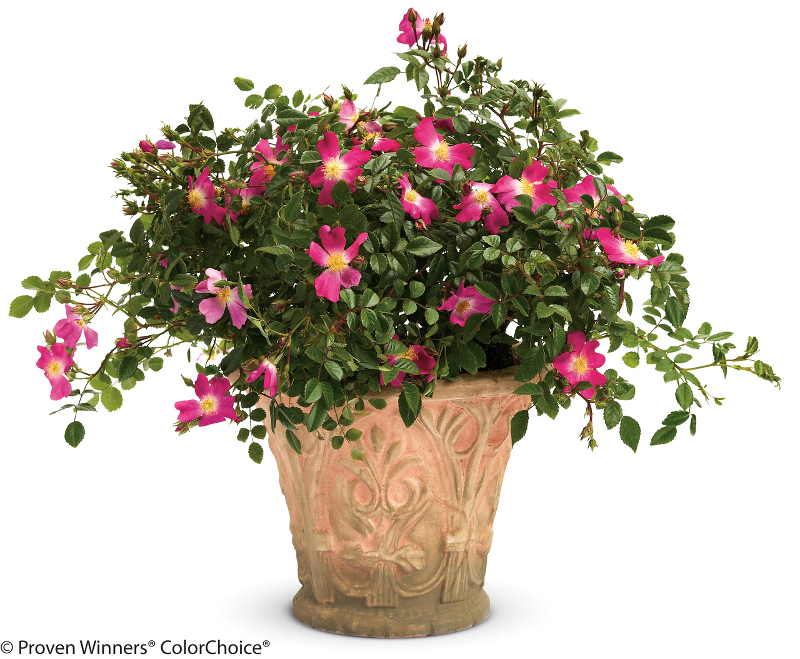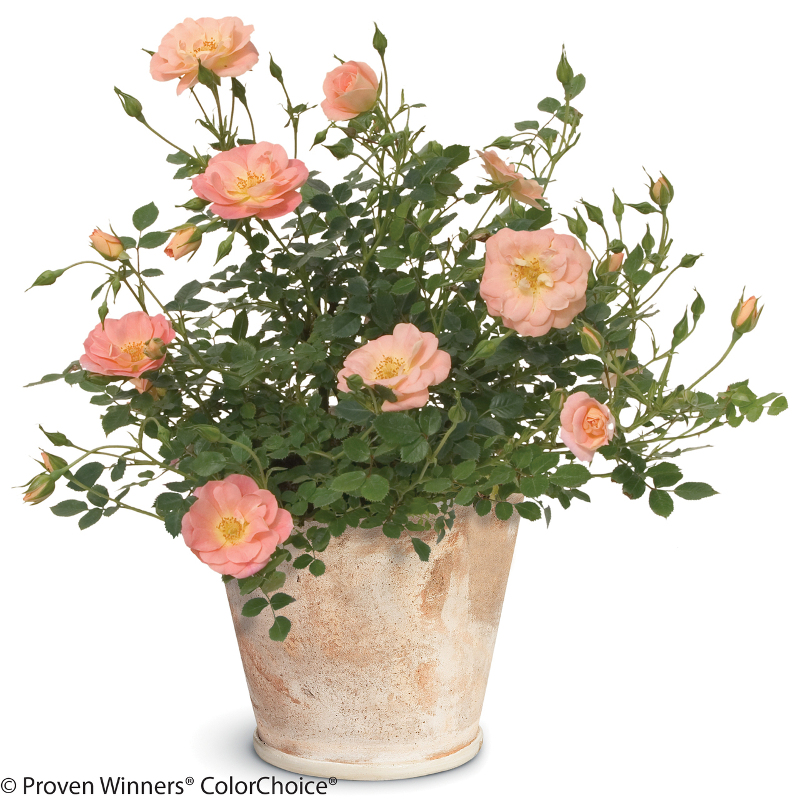The rose is the national floral emblem of the United States and continues to be America’s favorite flower. With over three hundred species of roses, there is no better choice for your container garden area. Potted roses are perfect for patios, balconies, stairways, decks, or entryways. Wherever you decide to place your container grown rose, make sure it is a place that will receive a minimum of 6 hours of sun.

Not all rose varieties will thrive in pots. Larger rose varieties such as climbers and shrub roses should not be grown in standard pots but may grow well in taller containers 2 ½ to 4 feet deep. Miniature roses are best suited for containers. Miniature refers to the size of the bloom, not the size of the shrub. Do not confuse the “Miniflora” rose with a miniature rose. A Miniflora is larger than a miniature rose and does not work as well in a container.
When choosing a rose variety, look for small shrub roses instead. Small floribundas typically grow 18-24” tall, and miniatures top out at 10-24". Micro-mini roses grow 6-12” tall.
Planting Roses in Pots
Potted roses can successfully be planted any time of the year. For optimal enjoyment of the blooms, early spring would be a good idea. Container roses should be spaced two to three feet apart so the leaves of each plant do not touch. Good air flow between shrubs helps to prevent rose diseases. Stage the containers in an area that gets a minimum of 6 hours of full sun each day. Lots of sun helps with continued blooming of roses.
 Full sun will heat up your container so be cautious of the type of container you choose. Dark colored pots will heat up faster and could stress out rose roots during hot spells. Clay and terra cotta pots will keep roots cooler, but tend to be heavy to move. Lightweight plastic and resin containers have come a long way. They do not get as hot as clay pots, often look like terra cotta, and can be easily spray painted to suit your needs.
Full sun will heat up your container so be cautious of the type of container you choose. Dark colored pots will heat up faster and could stress out rose roots during hot spells. Clay and terra cotta pots will keep roots cooler, but tend to be heavy to move. Lightweight plastic and resin containers have come a long way. They do not get as hot as clay pots, often look like terra cotta, and can be easily spray painted to suit your needs.
Whichever material you choose, be sure that the pot has drainage holes. Roses do not like wet feet. Roots that sit in water can easily rot.
Most rose shrubs will grow well in containers as long as there is enough space for the roots to grow. Generally, roses planted in containers will not grow as large as those planted in the ground, so the bigger the pot, the better. Miniature roses are perfect for window boxes, hanging baskets or a 5 gallon pot. Smaller floribundas, and polyantha variety roses will be happy in a 10 gallon container.
Hybrid tea roses and small to medium sized shrub roses will need a 15 gallon container. Large shrub roses and climbers will need 20 to 30 gallon containers.
Best Soil For Roses in Pots
When planting roses, a rich well draining soil will make your container rose happy. A potting mix and compost combination of ⅓ compost and ⅔ potting mix is ideal. Adding a layer of well-rotted manure or mulch on top of the soil will help to conserve moisture.
Caring For Roses in Planters
Your container roses will need to be in a location that gets 6 hours of full sun each day. When grouping pots together, space each pot at least 2 feet apart to provide good air circulation. Roses like moist, well-drained soil.
Consistent watering is important for the health of the plant. Daily watering during the morning hours is recommended, especially on hot days. It is best that the foliage on roses is dry overnight which helps to prevent fungal diseases. In general, roses are heavy feeders. Potted roses will require more fertilizing than garden grown roses. Use a slow-release rose fertilizer in the spring.
Throughout the growing season, a monthly feeding of a liquid rose food can help with better flower production. Deadheading spent blooms will also encourage the growth of fresh flowers. It is a good idea to re-pot your roses every couple of years. This will give your rose a fresh supply of nutrients for overall better health.
Watering Roses in Pots
Regular watering and fertilizing are important for the health of the rose shrub. Throughout the growing season, the soil should be kept evenly moist, but not so much that it drowns the plant. The general rule is one inch of deep watering per week. Slowly saturate the soil until the water runs from the drainage holes.
When watering, it is best to keep the water off of the foliage. Wet leaves can lead to powdery mildew and other fungal issues. Roses like moist well drained soil. It is best to avoid watering during the hottest parts of the day as evaporation is faster during this time.
Fertilizing Roses in Pots
Along with good watering, fertilizing your roses is needed for proper growth. Roses are heavy feeders. Container grown roses require more frequent feeding than garden planted rose shrubs. Apply a balanced fertilizer designed for roses every other week to help with vigorous blooming and continued growth.
In the spring, you can also add a tablespoon of Epsom salts around the base of the plant to aid with healthy foliage. Adding 1 cup of bonemeal to the soil mixture helps with blooming. For added nutrients, you can also add fishmeal or blood meal to the soil.
Winter Care For Roses in Pots
In colder climates, container roses will need a bit of extra care to overwinter successfully. Begin by halting the fertilizing in late July. Too much feeding late in the season can encourage growth that will just be damaged when the cold arrives. In early September, stop deadheading spent blooms. This will encourage strong wood and increased cold tolerance.
Many gardeners prefer to overwinter their container roses indoors. The entire pot can be moved to an insulated yet unheated location such as a shed, basement, or garage where the temperature stays near the freezing mark. Water sparingly only when the soil is dry to the touch, usually once a month.
Another option is to bury the entire pot in the ground for the winter months. Find a garden area and dig a hole deep enough to bury the pot. Add mulch, straw, or shredded leaves to help insulate the plant. Remove the pot in the spring when you see buds beginning to form.

Can Roses Be Grown Indoors
Most rose varieties can successfully grow indoors as long as the right conditions are provided. A room or window area that gets 6 hours of sun each day is optimal. Daytime temperatures in the room should be 70-75 F, with nighttime temperatures of around 60 F. Do not crowd the containers together. Roses need good air circulation to help prevent diseases.
Water the roses each day or every other day allowing a small amount of water to remain in the drip tray. Apply a water soluble fertilizer once a month. To encourage new growth, prune blooms as soon as they fade. It is best to re-pot indoor roses once a year to provide fresh soil nutrients.
Plants We Recommend
 |
Author Chris Link - Published 05-28-2021 |
